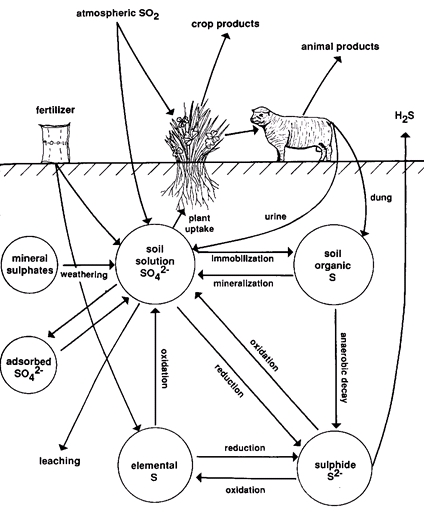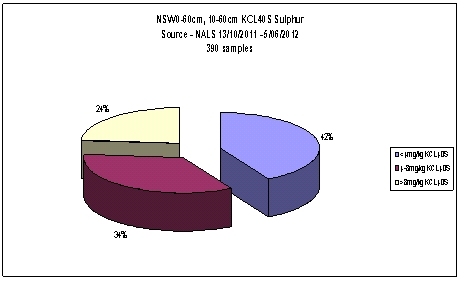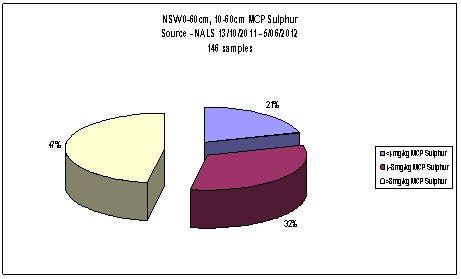Sulphur in northern Vertosols
Author: Chris Guppy, University of New England | Date: 05 Mar 2013
Chris Guppy, University of New England
Take home message
- Sulfur deficiency is not yet widespread.
- Crop residues are important in recycling S in cropping systems
- Appropriate soil testing strategies are important in future monitoring
Evidence of S deficiency in crops following recent wetter seasons has prompted a request for updated information on S cycling in the northern grains region. This paper will summarise the S cycle in soils and highlight the key processes affecting the availability of S in northern cropping soils, update advisors and producers on S testing and critical values and outline the current direction of S research in the region.
The sulfur cycle in soils
The sulphur cycle has been well characterised for many years (Figure 1). The key processes in northern cropping soils are the reactions between soil solution sulphate and soil organic S, solution sulphate and adsorbed sulphate and loss of S by leaching. Two important processes that aren’t highlighted in Figure 1 are the movement of S from crop residues into the soil directly rather than through an animal and the tendency for S to accumulate in the soil profile in the form of gypsum.
From a crops point of view, the majority of the S it acquires early in the life cycle is most likely derived from immediate release of S from crop residues that remains in the surface soil, and mineralisation of S from organic matter over the fallow period. Sulfur behaves in a similar manner to N with respect to fallow build up as an anion (sulfate and nitrate). As micro-organisms consume labile organic matter, they release excess S as sulfate into the soil solution which is available for plant uptake and/or leaching. This is the same process that releases N as ammonium which then nitrifies to nitrate.
However sulfate is not quite as readily leached as nitrate and can remain higher up the soil profile for longer periods of time. The reason sulfate does not leach as readily is two-fold. First, sulfate is slightly more reactive with the clay in the soil, some of it is specifically attracted and retained against leaching. Second, as soils dry out, water that may have filled large pores and diluted the S to a soluble form susceptible to leaching retreats to smaller pores and the sulfate becomes more concentrated. As the concentration of sulfate increases it reaches a critical stage where it begins to react with Ca in solution to form gypsum. Once in the form of gypsum it is not as susceptible to leaching and the movement of S down the profile stalls, until conditions again become wet enough to dissolve the gypsum into its constituent parts once more. This is an extra step in the process which slows movement of S relative to movement of nitrate. One consequence of this is layers of gypsum in bands in the subsoil; the depths of these bands are most likely related to the frequency of periods of inundation.

Figure 1: The sulphur cycle (McLaren and Cameron 1996)
Continuing the crop’s view of S, residue S and mineralised organic S most likely constitute the first sources of S that the crop sees. If these are inadequate because there has been prolonged inundation that has moved sulfate beyond the reach of young root systems, then transient S deficiency may be observed. Sulfur deficiency is observable as pale yellowing of the younger leaves in most instances. However, should the root system get deep enough, it may then find reserves of S in the subsoil from the leaching front and recover from the transient deficiency. Hence the need to consider sampling depths closely.
Sulfur status of the northern grains region
Responses to S have been observed but are often confused with N responses. The frequency of S responses increased in the late 80’s and early 90’s as lower S analysis fertilisers were increasingly used, and removal of S in crops exceeded replacement. Shifting to zero tillage systems though, with less incorporation of residues (or even burning of stubble (a major previous loss mechanism)), slowed down the loss of S and increased the cycling of crop S through residue return. However, as S is predominantly found in organic matter, particularly in the surface soil, the long-term run-down in soil organic matter will ultimately result in widespread S deficiency. Unlike coastal areas, where in excess of 20 kg S/ha is received in rainfall the NGR receives only from 1 to 2 kg S/ha in rainfall.
Long-term Colonsay data presented at the Australian Society of Agronomy conference in 2001 indicated S responses in grain sorghum were remediated with S additions of 10-30 kg/ha. However, these additions did not result in increased uptake of S in the grain and the N:S ratios of grain were unchanged. In fact, grain sorghum S concentrations were stable and don’t seem to reflect S deficiency effectively and warrant further research. This contrasts with annual cereals where there is better evidence that grain S is indicative of deficiency, and concentrations are falling in the northern grain region.
Incitec (through Jim Laycock) kindly granted access to S soil test results prior to the last season in the NGR (Figure 2 and 3). 75% of the samples over this depth had less than 8 mg/kg S when extracted with KCl-40, and more than half were lower when extracted with MCP. MCP will normally extract more S from Vertosols due to the higher concentration of the extractant and the ability to removed sorbed S from clay.

Figure 2: Profile (0-60 or 10-60cm) KCl40-S concentrations in the NSW for summer 2011/2012 soil samples.

Figure 3: Profile (0-60 or 10-60cm) MCP-S concentrations in the NSW for summer 2011/2012 soil samples.
Less than a quarter of soils have less than 4 mg S/kg of MCP-S in the upper profile, and these results would suggest that at least half the sites sampled had accumulated subsoil S. Responses to S are not usually observed where surface samples (0-10cm) are at least 3 mg/kg. Hence, even in samples with <4 mg S/kg in the top 60cm, surface values will rarely fall below this. It is worth noting that perusal of CQ soil tests reveals some very low S profiles throughout. The lack of response to applied S may be a function of other elements (N, P, K) being even more limiting than S in these environments.
Gaps in S knowledge
Outside of annual cereals, where responses may be observed below 3 mg/kg KCl-40 S, the critical response values for other important crops in the NGR are not known. This is of particular concern for legumes (with a higher S requirement) and will be an issue when canola becomes a more common crop in northern regions.
The work undertaken at Colonsay suggested that 0-60 cm depth samples were slightly better correlated with grain sorghum response than shallower or deeper depths. However, work has not continued on defining critical response values, or depths over which soil S should be assessed. Advisors and producers are encouraged to measure S to depth at least once every 5 years and in increments that will allow identification of gypsum layers containing subsoil reserves of S. A measurement of 0-10, 10-30, 30-60 and 60-90, every 5 years, with more frequent monitoring of surface layers (particularly following flooding events) is advised.
Finally, there is little understanding of where the ‘cliff’, with respect to labile organic matter depletion, and slow mineralisation of S reserves actually is. As labile organic matter is used and more recalcitrant, resistant organic material remains, the replenishment of surface S reserves will decline and increasing S responses will most likely be observed. Despite much investment in carbon research, it is questions such as these that will be of more benefit to producers in the long term.
Current S research
Current research within the third iteration of the Nutrient Management Initiative has included S treatments in multiple nutrient deficiency response trials, recognising that soil test values are falling, organic matter reserves that may resupply S are depleted and removal is still in excess of application. It is hoped that funding is found to enable these trials to be analysed completely, however currently there is insufficient funding to allow profile responses or critical values for species other than wheat to be developed. Within GRDC national nutrient management initiatives, a program to develop and investigate a DGT-S test (in conjunction with DGT-P/K) is currently funded out of Adelaide, and soils from northern region will be sent to Adelaide and examined within that program.
Acknowledgements
David Lester, Mike Bell and Jim Laycock and Graeme Blair for access to their considerable expertise!
Contact details
Dr Chris Guppy
UNE
Ph: 02 6773 3567
Fx: 02 6773 3238
Email: cguppy@une.edu.au
Reviewed by
Graeme Blair
Was this page helpful?
YOUR FEEDBACK
